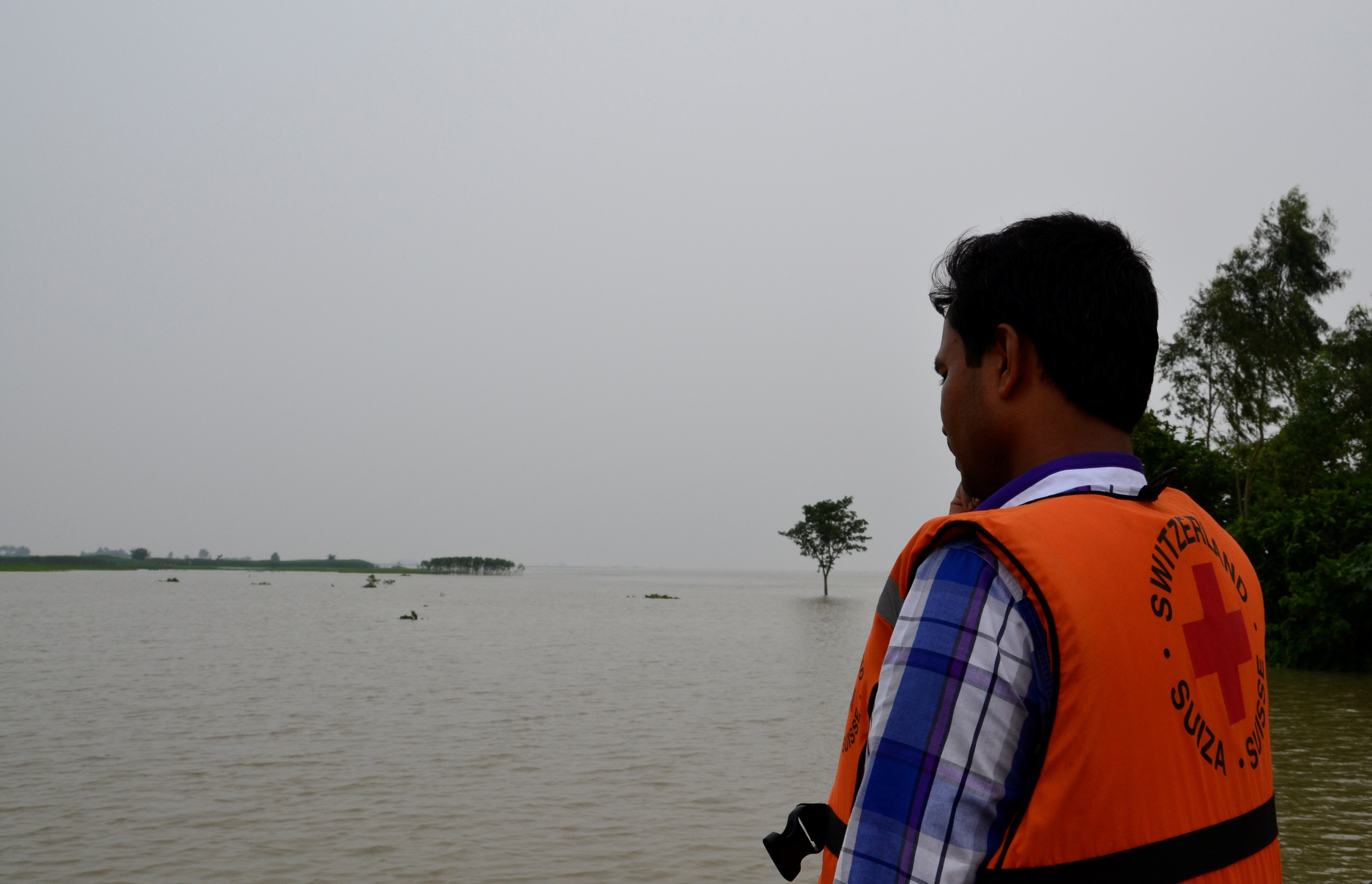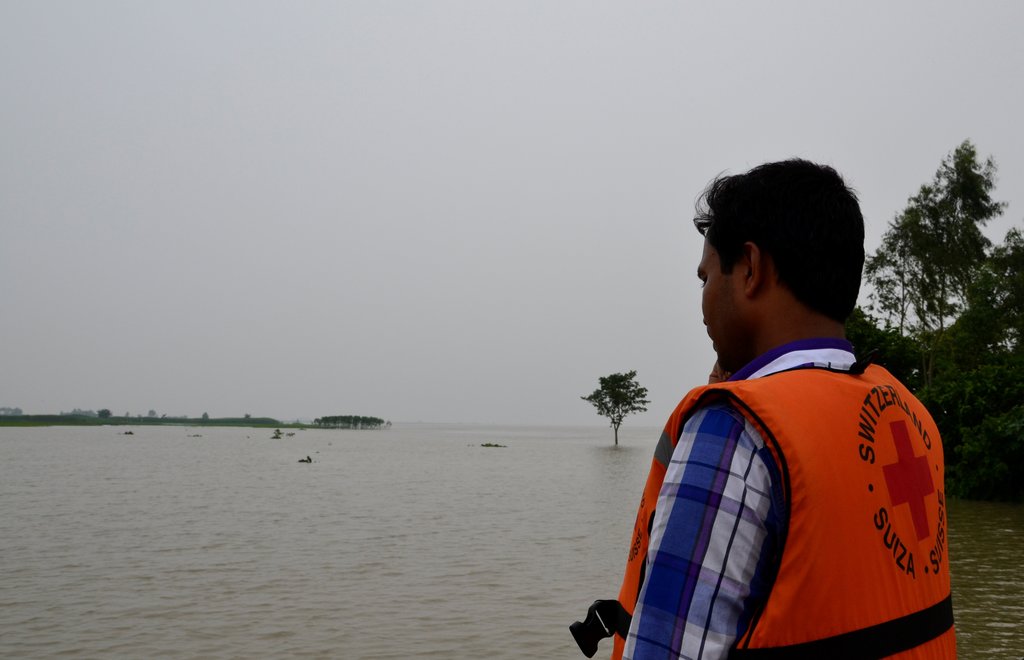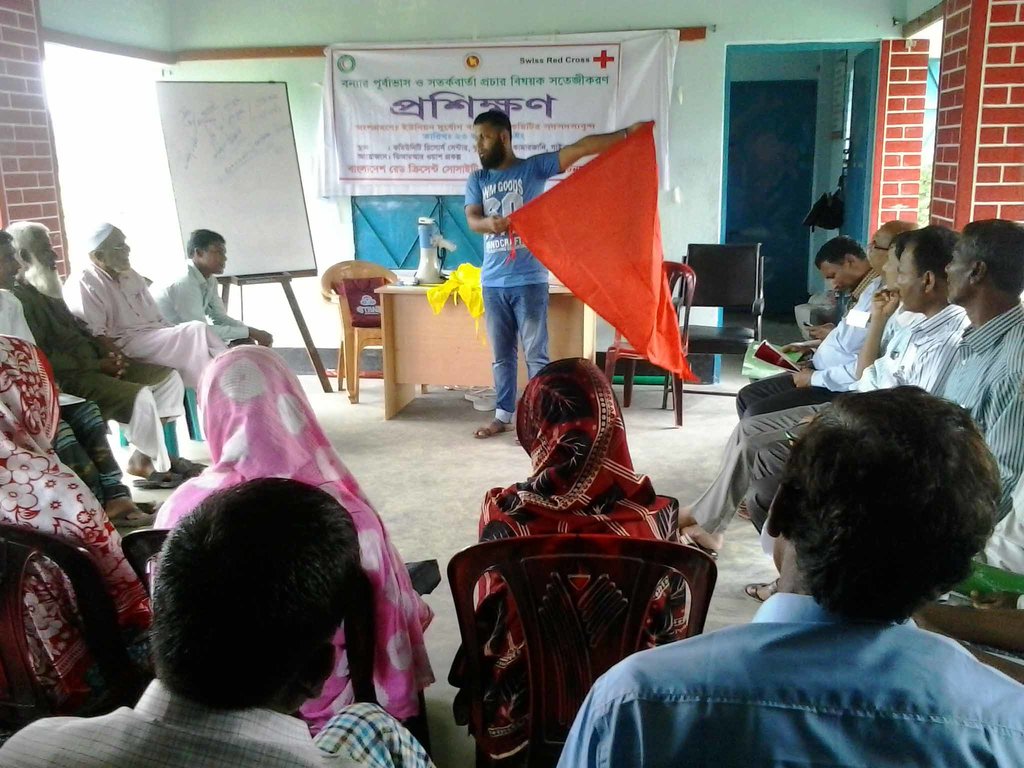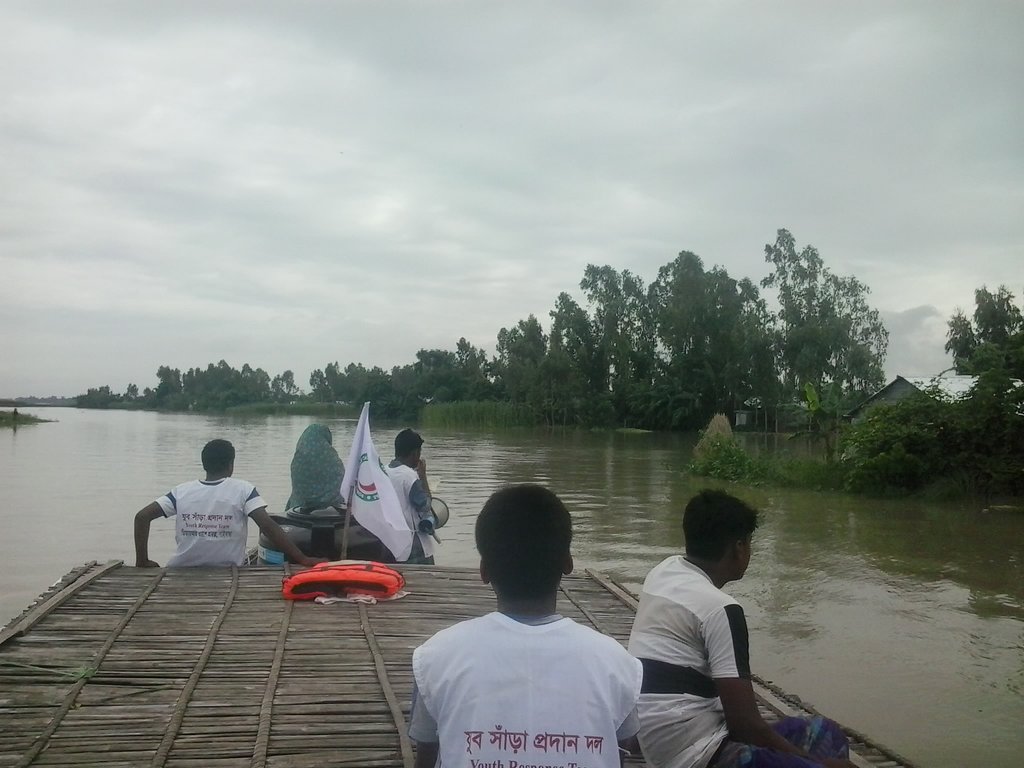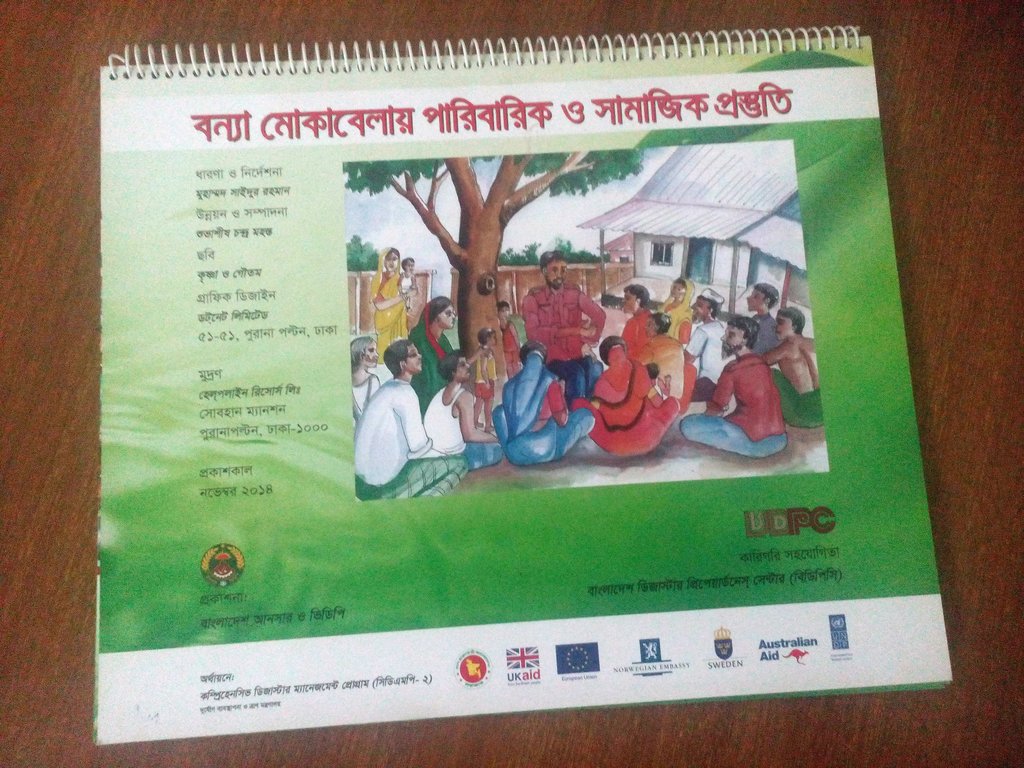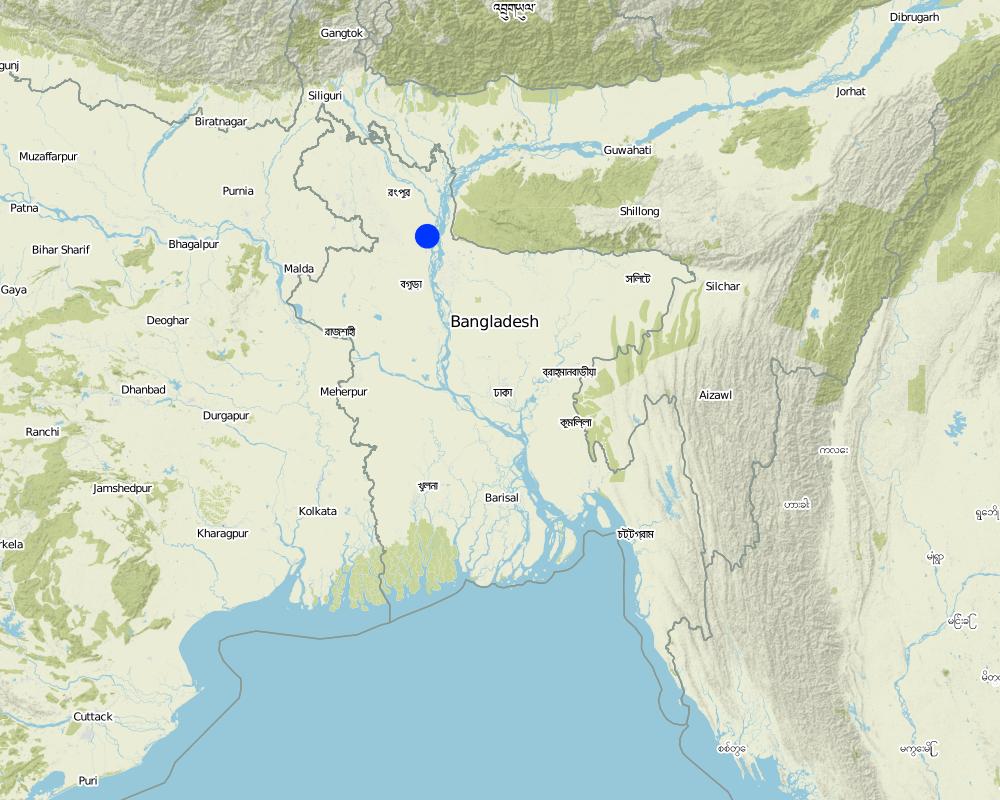Early Warning Message Dissemination [บังกลาเทศ]
- ผู้สร้างสรรค์:
- การอัพเดท:
- ผู้รวบรวม: TUHIN SAMADDAR
- ผู้เรียบเรียง: Anton Jöhr
- ผู้ตรวจสอบ: Alexandra Gavilano, Alvin Chandra
বন্যা পূর্ব-সতর্কবার্তা প্রচার (Bonna Purbo-Satarkabarta Prochar)
approaches_649 - บังกลาเทศ
ดูส่วนย่อย
ขยายทั้งหมด ย่อทั้งหมด1. ข้อมูลทั่วไป
1.2 รายละเอียดที่ติดต่อได้ของผู้รวบรวมและองค์กรที่เกี่ยวข้องในการประเมินและการจัดเตรียมทำเอกสารของแนวทาง
วิทยากรหลัก
Project staff:
Mustafa Golam
+880 1718770373 / +880 1730799762
pmdrrwash16@gmail.com
Bangladesh Red Crescent Society
Project Manager, DRRWASH Project O⌀ਈce, Shukhsantir Bazar, Dhanghora, Gaibandha, Bangladesh
บังกลาเทศ
Project staff:
Razzak Abdur
+880 1730 799763 / +880 1730 799763
razzak.pe@gmail.com
Bangladesh Red Crescent Society
Project Engineer, DRRWASH Project O⌀ਈce, Shukhsantir Bazar, Dhanghora, Gaibandha, Bangladesh
บังกลาเทศ
Project staff:
Islam Saiful
+880 1730 799746 / +880 1730 799746
saiful644@gmail.com
Bangladesh Red Crescent Society
Field Officer DRR and Training, DRRWASH Project O⌀ਈce, Shukhsantir Bazar, Dhanghora, Gaibandha, Bangladesh
บังกลาเทศ
ชื่อของโครงการซึ่งอำนวยความสะดวกในการทำเอกสารหรือการประเมินแนวทาง (ถ้าเกี่ยวข้อง)
Book project: where people and their land are safer - A Compendium of Good Practices in Disaster Risk Reduction (DRR) (where people and their land are safer)ชื่อของโครงการซึ่งอำนวยความสะดวกในการทำเอกสารหรือการประเมินแนวทาง (ถ้าเกี่ยวข้อง)
Swiss Red Cross (Swiss Red Cross) - สวิตเซอร์แลนด์1.3 เงื่อนไขที่เกี่ยวข้องกับการใช้ข้อมูลที่ได้บันทึกไว้ผ่านทาง WOCAT
วันที่เก็บรวบรวมข้อมูล (ภาคสนาม):
04/10/2016
ผู้รวบรวมและวิทยากรหลักยอมรับเงื่อนไขเกี่ยวกับการใช้ข้อมูลที่ถูกบันทึกผ่านทาง WOCAT:
ใช่
1.4 การอ้างอิงถึงแบบสอบถามเรื่องเทคโนโลยี SLM
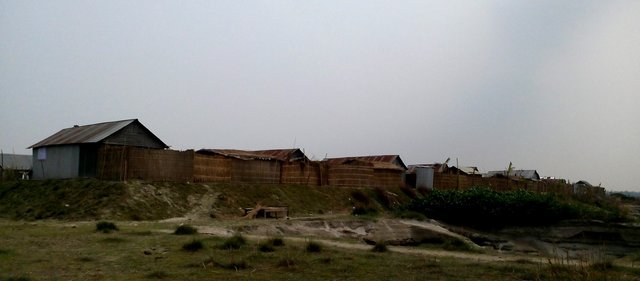
Emergency infrastructure including shelter and linked transport infrastructure [บังกลาเทศ]
Emergency infrastructure including shelter and linked transport infrastructure, consists in establishing specific flood shelters (for people and animals) including flood-proof collective water sources and communication infrastructure as well as health and school facilities that may serve at the same time as emergency shelters during floods.
- ผู้รวบรวม: TUHIN SAMADDAR
2. คำอธิบายของแนวทาง SLM
2.1 การอธิบายแบบสั้น ๆ ของแนวทาง
An effective system for dissemination of early warning messages was established among the vulnerable communities in Chars (riverine sandy islands) of Gaibandha district, Bangladesh, in order to strengthen their coping mechanisms and reduce loss and damage caused by floods.
2.2 การอธิบายอย่างละเอียดของแนวทาง
การอธิบายอย่างละเอียดของแนวทาง:
Early warning systems are an essential element in building resilience through effective disaster preparedness and risk mitigation: the key characteristics of the approach entail linking the intervention units at community level with national and sub-national early warning systems. It also consists of developing the capacity of the local government institutions and organised communities to not only disseminate early warning but to effectively respond to floods. Merely installing an early warning system is not sufficient to equip communities to cope with recurrent floods; it needs to be linked to broader aspects of disaster preparedness and increased response capacity of communities and local government.
The vulnerability and capacity assessment (VCA) is the basis of all measures oriented at reducing disaster risks. The VCA was carried out with the involvement of local stakeholders, especially the target communities, to understand the vulnerabilities and risks associated with floods as well as to gain insight on existing capacities and capacity gaps that needed to be addressed. The process resulted in a risk reduction action plan which was to be jointly implemented by the target community and local government.
The risk reduction plan pointed to the need of having in place a mix of structural, management and contingency measures. This involved linking local, sub-national and national early warning systems, developing contingency and evacuation plans supported by establishment of safe places where people could move during floods. The risk reduction plan also highlighted the need to support household level protection measures - structurally this meant raising household plinth levels above flood levels. In addition, local early warning system was established through installation of flood markers/pillars, and warning flags at key sites. Capacities were built to internalise, monitor and consequently respond to evolving local flood situation.
Building communication channels that link the local institutions to higher level flood forecasting system resulted in streamlining information from source to destination. The weather forecast communication flow is both vertical and lateral – vertically it is a mix of web-based flood information and mobile telephony which begins at the Flood Forecast Warning Centre (FFWC) - the apex body that monitors flood situation in Bangladesh. FFWC transmits information to the sub-national local governments that have digital centres with trained personnel to access information from FFWC website. Trained entrepreneurs at these digital centres are responsible for monitoring flood forecasts and updating the Union Parishad (the lowest level of local body) and communities on evolving flood situation. By analysing and interpreting relevant information they play a key role in catalysing the early warning system. The local bodies , Union Parishads, use a mix of communication modes - such as miking (public address system), radio and cellular phone - to transfer early warning information to the communities. On the other hand, flood markers are installed locally that are adjusted according to increase in water levels. Designated trained persons – Youth Response Team - take the responsibility to do this. This is monitored by community and the Union Parishad.
In normal times, drills and simulations are conducted by trained team of village volunteers/first responders. They take the lead in organising evacuation and movement to safe places. The government (and project) brings in the logistic support, especially transportation, to facilitate evacuation and movement to safe places.
2.3 รูปภาพของแนวทาง
ข้อสังเกตทั่วไปเกี่ยวกับรูปภาพ:
Approach of Early Warning System in DRRWASH project area in Gaibandha district.
2.4 วีดีโอของแนวทาง
ความคิดเห็น อธิบายสั้นๆ:
Video on Flood 2015 in the DRRWASH project area in Gaibandha including early warning intervention, in Bangla, link:
https://www.youtube.com/watch?v=Os4ZgSMMVyg
วันที่:
25/10/2015
สถานที่:
Gaibandha
ชื่อของผู้ถ่ายวีดีโอ:
Tuhin Samaddar and Vabotosh Karmakar
2.5 ประเทศ ภูมิภาค หรือสถานที่ตั้งที่ได้นำแนวทางไปใช้
ประเทศ:
บังกลาเทศ
ภูมิภาค/รัฐ/จังหวัด: :
North-Bengal
ข้อมูลเฉพาะเพิ่มเติมของสถานที่ตั้ง:
Kamarjani and Mollar Char union in Sadar Upazila and Haldia union in Shaghata Upazila of Gaibandha District
ความคิดเห็น:
The entire intervention area is divided into 261 clusters. In each cluster, one local volunteer (YRT) has been nominated for preparedness and response operation. 30 Village Disaster Management Committee (VDMC) are actively monitoring the process under the guidance of three Union Disaster Management Committee (UDMC).
Map
×2.6 วันที่เริ่มต้นและสิ้นสุดของแนวทาง
ระบุปีที่เริ่ม:
2013
ถ้าไม่รู้ปีที่แน่นอนให้ประมาณวันที่ที่ริเริ่มใช้แนวทางนี้ :
น้อยกว่า 10 ปี (เร็วๆนี้)
2.7 ประเภทของแนวทาง
- ใช้โครงงานหรือแผนงานเป็นฐาน
2.8 เป้าหมายหรือวัตถุประสงค์หลักของแนวทาง
To promote resilient communities through improved flood preparedness that reduces loss and damage of vulnerable people's lives and protects their livelihoods in the chars of Gaibandha district.
2.9 เงื่อนไขที่เอื้ออำนวยหรือเป็นอุปสรรคต่อการนำเทคโนโลยีภายใต้แนวทางนี้ไปปฏิบัติใช้
บรรทัดฐานและค่านิยมทางสังคม วัฒนธรรม ศาสนา
- เอื้ออำนวย
The intervention built upon traditional coping mechanisms and indigenous systems of disaster risk management. The blending of the traditional and indigenous practices with contemporary knowledge and preparedness practices acted as drivers in terms of choice and adoption of technologies.
- เป็นอุปสรรค
In earlier phases of the intervention, the cultural norm of not abandoning one's household even in extreme crisis hindered timely access to emergency infrastructure.
การมีไว้ให้หรือการเข้าถึงแหล่งการเงินและบริการ
- เอื้ออำนวย
The DRR intervention facilitated leveraging of institutional financial resources (Local government budget) and secured cost contribution from target communities.
- เป็นอุปสรรค
Lack of adequate capacities and resources with local government.
การจัดตั้งระดับองค์กร
- เอื้ออำนวย
The Disaster Management Act and Standing Orders on Disaster of the Govt. of Bangladesh provides for a decentralised disaster management institutional setting from the central level to the local level.
- เป็นอุปสรรค
In principle a decentralised disaster management structure is in place but due to operational and financial constraints they are unable to perform their mandated function.
การร่วมมือหรือการทำงานประสานกันของผู้ลงมือปฏิบัติ
- เอื้ออำนวย
The initiative built a good coordination with state actors at various levels. From time to time it was also able to secure collaboration from non-state actors around specific thematic areas such as obtaining livelihood support in non-farm sector, synergising disaster risk management work, ensuring access of vulnerable communities to social protection measures.
- เป็นอุปสรรค
Harmonisation of disaster centred initiatives is a time consuming process and very often does not lead to collaborations that harness existing synergies.
กรอบแนวทางในการดำเนินการด้านกฎหมาย (การถือครองที่ดิน สิทธิในการใช้ที่ดินและน้ำ)
- เอื้ออำนวย
Disaster Management Act, 2012 provides the legal framework for disaster risk management in Bangladesh.
นโยบาย
- เอื้ออำนวย
A set of policies supports the Disaster Management Act. Government's standing orders on disaster clearly defines the roles and responsibilities of various ministries, line agencies, local govt., mandated committees and other non-state actors in disaster risk management.
- เป็นอุปสรรค
Policy enforcement across sectors remains weak in Bangladesh.
การกำกับดูแลที่ดิน (การตัดสินใจ การนำเอาไปปฏิบัติใช้ และการบังคับใช้)
- เอื้ออำนวย
Traditional rights to land are still accepted in Chars of Bangladesh .
- เป็นอุปสรรค
Land ownership is complex in Chars given its unstable nature due to high vulnerability to river erosion. Char lands are controlled by the local elites, often residing in the mainland, who use their political influence to secure govt. collusion/indifference (though char lands officially belong to them) in exercising land ownership and land transactions. Eventually it is the elites who lease and/or rent out land to the char population.
ความรู้เกี่ยวกับ SLM การเข้าถึงการสนับสนุนด้านเทคนิค
- เอื้ออำนวย
Timely weather forecast allows communities to accordingly time their agricultural operation, especially the sowing operations
- เป็นอุปสรรค
River erosion threats strongly disincentivise investment in SLM.
ตลาด (จัดซื้อปัจจัยนำเข้า ขายผลิตภัณฑ์) และราคา
- เป็นอุปสรรค
Market forces are yet to develop properly in Chars which are by nature isolated geographical units, accessed only through time consuming and expensive transportation means.
ปริมาณงานที่ทำได้ กำลังคนที่มีให้
- เอื้ออำนวย
Higher productivity of land in Chars allow for lower labour engagement in agriculture.
- เป็นอุปสรรค
Disaster and higher profitability in mainland drives migration leading to labour shortages.
3. การมีส่วนร่วมและบทบาทของผู้มีส่วนได้ส่วนเสียที่เกี่ยวข้อง
3.1 ผู้มีส่วนได้ส่วนเสียที่เกี่ยวข้องในแนวทางนี้และบทบาท
- องค์กรที่ขึ้นอยู่กับชุมชน
Village Disaster Management Committee (VDMC)
The VDMC is the key actor to perform disaster risk reduction activities in the communities. The covers supporting the conduct of VCA, conducted by external facilitators, by extending logistic support and securing representative participation of larger community (non-VDMC members) in the VCA process. The VCA helps VDMCs develop their action plans. The operationalisation of the plans is anchored in the VDMC and so is leveraging cooperation and collaboration from local government. The VDMC also acts as first responder and as custodian responsible for operation and maintenance of built emergency and health infrastructure. Assessing community needs, beneficiary selection, contribution collection and financial management of hardware are their other key responsibilities.
Contribution collection means mediating and collecting the contribution of users/ beneficiaries and local governments to the costs of the built facilities (plinth raising, WASH, flood shelters, etc.) in pre-agreed proportion.
Financial management of hardware refers to VDMCs engaging in all aspects of the construction process of small scale communal and household mitigation options (flood shelters, roads, bridges, household plinth raising, etc. ) and shouldering financial management responsibilities related to their construction and subsequent operation and maintenance. This involves managing finances (contribution from users/LGI/project); giving work contract and settlement of payment following work completion.
- ครู เด็กนักเรียน หรือนักศึกษา
Youth Response Team (YRT) members
YRT has been developed to promote volunteerism. Their main role is to support response and recovery operations during and after disaster. They are especially trained in Search & Rescue. As they are located in the community, YRTs actively engage in early warning dissemination. They act as focal person for monitoring and adjusting the flood markers. They support the Union Parishad in transmitting early warning to communities (as mentioned above) and supporting the evacuation of communities to safe places.
- ภาคเอกชน
Enterpreneur of Union Digital Center
The lowest level of local government, the Union Parishad (UP), has a Digital Center to render ICT services to communities. These are run by local entrepreneurs. The entrepreneurs are responsible for monitoring flood forecasts on the internet and updating the Union Parishad (UP) and community-based organisations (CBOs) on evolving flood situation. By analysing and interpreting relevant information they play a key role in catalysing the early warning system.
- รัฐบาลระดับท้องถิ่น
Union Disaster Management Committee (UDMC)
The UDMC disseminates forecasts, warnings, and advisories locally. It also performs a lead role in response and recovery operations.
ถ้ามีผู้มีส่วนได้ส่วนเสียหลายคนที่เกี่ยวข้องให้ระบุหน่วยงานตัวแทน:
UDMC
3.2 การเกี่ยวข้องของผู้ใช้ที่ดินระดับท้องถิ่นหรือชุมชนระดับท้องถิ่นในช่วงต่างๆของแนวทาง
| ความเกี่ยวข้องของผู้ใช้ที่ดินระดับท้องถิ่นหรือชุมชนระดับท้องถิ่น | ระบุผู้ที่มีส่วนเกี่ยวข้องและอธิบายกิจกรรม | |
|---|---|---|
| การริเริ่มหรือการจูงใจ | ปฏิสัมพันธ์ | Key Actors: VDMC/CBOs and Local Government Institutions (UDMC) Activities : formation of CBOs, reformation of UDMC, VCA and volunteer selection |
| การวางแผน | ปฏิสัมพันธ์ | Key Actors: VDMC/CBOs and Local Government Activities: preparation of risk reduction action plan, preparation of evacuation plan along with map of evacuation routes (route to be taken for the evacuation in moving to safe places), contingency plan development, planning of emergency and health infrastructure, Early Warning Systems (EWS) planning |
| การดำเนินการ | ปฏิสัมพันธ์ | Key Actors: VDMC/CBOs and Local Government Activities: Establish Early Warning System, emergency infrastructure, access infrastructure (wooden bridge, roads, etc.), household infrastructure |
| การติดตามตรวจสอบหรือการประเมินผล | ระดมกำลังด้วยตนเอง | Key Actors: VDMC/CBOs, Local and Sub-national Government Activities: Developing Quality Assurance System, Community Review Meeting, Site visits/physical verification, quality and financial audit, survey and spot checks, |
| Initiation | ระดมกำลังด้วยตนเอง | Ket Actors: VDMC/CBOs, Local Government and Private Sector: Activities: O&M of built infrastructure and Sanitation Marketing which involves supporting local entrepreneurs to establish local supply chains of toilet building materials through their own investment and build toilets for users that bear the costs. The project does not build latrines directly but rather mediates the linkages of users with the sanitation entrepreneurs |
3.3 แผนผังแสดงขั้นตอนการทำงาน (ถ้ามี)
คำอธิบาย:
The flow chart explains application of the EWS and clarifies local linkages with national flood forecasting and warning centre (FFWC)
ผู้เขียน:
Tuhin Samaddar
3.4 การตัดสินใจเลือกใช้เทคโนโลยี SLM
ระบุผู้ที่ทำการตัดสินใจเลือกเทคโนโลยีมากกว่าหนึ่งวิธีไปปฏิบัติใช้:
- ผู้ลงมือปฏิบัติที่เกี่ยวข้องทั้งหมดในฐานะที่เป็นส่วนรวมของแนวทาง
การอธิบาย:
Since participatory approach has been adopted to examine vulnerabilities and capacities, the approach and technology choice to address risk and vulnerabilities was collectively decided.
ระบุว่าการตัดสินใจตั้งอยู่บนพื้นฐานของ:
- สิ่งที่ค้นพบจากงานวิจัย
- ประสบการณ์และความคิดเห็นส่วนตัว (ไม่ได้ลงบันทึกไว้)
- Government policies and mandates
4. การสนับสนุนด้านเทคนิค การสร้างขีดความสามารถ และการจัดการด้านความรู้
4.1 การสร้างขีดความสามารถ / การอบรม
ได้มีการจัดอบรมให้แก่ผู้ใช้ที่ดินหรือผู้มีส่วนได้ส่วนเสียคนอื่น ๆ หรือไม่:
ใช่
ให้ระบุว่าใครเป็นผู้ได้รับการอบรม:
- ผู้ใช้ที่ดิน
- เจ้าหน้าที่ภาคสนาม / ที่ปรึกษา
- Anser-VDP (Village Defence Party) member
รูปแบบการอบรม:
- ใช้พื้นที่ทำการสาธิต
- จัดการประชุมสู่สาธารณชน
- จัดคอร์ส
หัวข้อที่พูด:
Several training courses and workshops were organised on disaster preparedness and response:
1. Early Warning System (for UDMC/VDMC/ Anser-VDP/YRT/VCRP/Staff): Disaster context in Bangladesh, techniques to identify water levels against standardised danger levels, determining flood intensity by observing pillars and flags, dissemination strategies for early warning messages among the community, and role of stakeholders to warning message dissemination.
2. Evacuation Plan (for VDMC/YRT/VCRP): Response operation, preparing checklist for response, preparing risk and resource map, information collection and analysis, preparing evacuation route maps, and roles and responsibilities of respective stakeholders in effectuating evacuation plan
3. Response Plan (for UDMC): Importance of response plan, key constituents of preparedness and response, interpretation of Early Warning information from FFWC, creating contingency fund, search and rescue, emergency relief and first aid, identifying safe exit route and transportation, damage assessment, launching control room, involving existing manpower and resources in the community and other organisation, and prepositioning of rescue equipments.
ความคิดเห็น:
609 VDMC/UDMC members were trained on various DRR topics. 255 local youth volunteers (YRT/VCRP) were also trained on early warning message dissemination, flood forecast interpretation, preparing evacuation plan and route map.
4 mock drill demonstration events were conducted by local government in which 276 community members participated. Refresher training was also organised for newly elected union parishad members on their broad mandate with specific reference to their roles and responsibilities in disaster risk management.
4.2 การบริการให้คำแนะนำ
ผู้ใช้ที่ดินมีการเข้าถึงการรับบริการให้คำปรึกษาหรือไม่:
ใช่
4.3 การเสริมความแข็งแกร่งให้กับสถาบัน (การพัฒนาองค์กร)
สถาบันได้รับการจัดตั้งขึ้นมาหรือเสริมความแข็งแกร่งโดยแนวทางนี้หรือไม่:
- ใช่ อย่างมาก
ระบุระดับของสถาบันที่ได้รับการเสริมความแข็งแกร่งหรือจัดตั้งขึ้นมา:
- ท้องถิ่น
- ภูมิภาค
อธิบายถึงสถาบัน บทบาทและความรับผิดชอบ สมาชิก เป็นต้น:
CBOs/Village Disaster Management Committee (VDMC)- on an average each CBO/VDMC has 17 members. Their roles and responsibilities entail assessments, beneficiary selection, developing and implementing Risk Reduction Action Plans (RRAPs) with special focus on disaster preparedness and response. A key function entails their engagement in Early Warning Systems (EWS) and planning and implementation of emergency and health infrastructure, shelter protection, and creating access infrastructure. Operation and Management of all built assets and infrastructure is their responsibility.
Local Government/UDMC: on average it has a 36 members. Standing orders on disaster of the government defines their roles and responsibilities which covers the entire gamut of functions associated with disaster risk management at the local level. Strengthening preparedness and leading effective response is critical to their mandate.
ระบุประเภทของการให้ความช่วยเหลือสนับสนุน:
- การสร้างขีดความสามารถ / การอบรม
- อุปกรณ์
ให้รายละเอียดเพิ่มเติม :
Megaphone, stretcher, Lifejacket, Lifebuoy, Torchlight, Raincoat, Gumboot, Rope and First aid box are some of the equipments that have been given to target communities. Further, the YRTs have received whistle, umbrella and apron for early response operation
4.4 การติดตามตรวจสอบและประเมินผล
การติดตามตรวจสอบและประเมินผลเป็นส่วนหนึ่งของแนวทางหรือไม่:
ใช่
ความคิดเห็น:
A joint monitoring team has been formed comprising representative of CBOs, local government and project staff.
ถ้าตอบว่าใช่ แสดงว่าการจัดเตรียมเอกสารนี้มุ่งหวังที่จะเอาไปใช้สำหรับการติดตามตรวจสอบและประเมินผลใช่หรือไม่:
ไม่ใช่
4.5 การวิจัย
การวิจัยเป็นส่วนหนึ่งของแนวทางหรือไม่:
ไม่ใช่
5. การสนับสนุนด้านการเงินและวัสดุอุปกรณ์
5.1 ระบุงบประมาณประจำปีสำหรับแนวทาง SLM นี้
ระบุงบประมาณประจำปีสำหรับแนวทาง SLM นี้ เป็นหน่วยดอลลาร์สหรัฐ:
10384.00
ถ้าหากว่างบประมาณประจำปีไม่เป็นที่ทราบแน่นอน ให้ระบุช่วงลงไป:
- 10,000-100,000
แสดงความคิดเห็น (แหล่งของการระดมทุน ผู้บริจาคคนสำคัญ):
Swiss Red Cross
Above mentioned amount is for the Early Warning System Implementation approach only
5.2 การสนับสนุนด้านการเงิน / วัสดุอุปกรณ์ให้แก่ผู้ใช้ที่ดิน
ผู้ใช้ที่ดินได้รับการสนับสนุนด้านการเงิน / วัสดุอุปกรณ์ไปปฏิบัติใช้เทคโนโลยีหรือไม่:
ใช่
5.3 เงินสนับสนุนสำหรับปัจจัยนำเข้า (รวมถึงแรงงาน)
- ไม่มี
ถ้าแรงงานโดยผู้ใช้ที่ดินเป็นปัจจัยนำเข้าที่มีอยู่มากมาย ระบุด้วยว่าเนื่องจาก:
- สมัครใจ
ความคิดเห็น:
All actions related to dissemination of early warning were performed on a voluntary basis.
5.4 เครดิต
มีการจัดหาเครดิตมาให้ภายใต้แนวทาง SLM หรือไม่:
ไม่ใช่
5.5 แรงจูงใจหรือเครื่องมืออื่น ๆ
แรงจูงใจหรือเครื่องมืออื่น ๆ ได้ถูกนำไปใช้ส่งเสริมการใช้เทคโนโลยี SLM หรือไม่:
ไม่ใช่
6. การวิเคราะห์ผลกระทบและการสรุป
6.1 ผลกระทบของแนวทาง
ทำให้ผู้ใช้ที่ดินระดับท้องถิ่นมีอำนาจขึ้น ปรับปรุงการเข้าร่วมของผู้มีส่วนได้ส่วนเสียให้ดีขึ้นหรือไม่:
- ไม่ใช่
- ใช่ เล็กน้อย
- ใช่ ปานกลาง
- ใช่ อย่างมาก
The participation of all local stakeholders, especially women, has improved considerably.
ช่วยในการตัดสินใจโดยดูจากหลักฐาน ได้หรือไม่:
- ไม่ใช่
- ใช่ เล็กน้อย
- ใช่ ปานกลาง
- ใช่ อย่างมาก
The decision making especially with regard to effectiveness and quality of approach and technologies has been determined by the evidence on the ground.
ช่วยให้ผู้ใช้ที่ดินนำเอาเทคโนโลยี SLMไปใช้และบำรุงรักษาสภาพไว้ได้หรือไม่:
- ไม่ใช่
- ใช่ เล็กน้อย
- ใช่ ปานกลาง
- ใช่ อย่างมาก
Since the implementation of technologies and maintenance of built infrastructure has been largely user led, it has improved their capacity to do the same.
ระดมกำลังหรือปรับปรุงการเข้าถึงแหล่ง เงินทุนสำหรับการดำเนินการ SLM หรือไม่:
- ไม่ใช่
- ใช่ เล็กน้อย
- ใช่ ปานกลาง
- ใช่ อย่างมาก
User contribution and govt. contribution was a mandatory component of the project which led to mobilisation of resources that supplemented project resources.
ปรับปรุงความรู้และความสามารถของผู้มีส่วนได้ส่วนเสียคนอื่น ๆ ให้ดีขึ้นหรือไม่:
- ไม่ใช่
- ใช่ เล็กน้อย
- ใช่ ปานกลาง
- ใช่ อย่างมาก
Implementation of well designed capacity building plan cognizant of the needs of diverse stakeholders has improved the knowledge and capacities of relevant stakeholders.
ทำให้ผู้ใช้ที่ดินระดับท้องถิ่นมีอำนาจขึ้น ปรับปรุงการเข้าร่วมของผู้มีส่วนได้ส่วนเสียให้ดีขึ้นหรือไม่:
- ไม่ใช่
- ใช่ เล็กน้อย
- ใช่ ปานกลาง
- ใช่ อย่างมาก
the central element of the approach has been to ensure sustainability of benefits which cannot be attained without strong institutions collaborating around disaster risk management work. Thus, the approach led to improved collaboration between stakeholders and strengthened institutions.
ช่วยบรรเทาความขัดแย้งหรือไม่:
- ไม่ใช่
- ใช่ เล็กน้อย
- ใช่ ปานกลาง
- ใช่ อย่างมาก
The approach is based on conflict sensitive programme management. This allowed for pro-active identification of conflicts and tensions followed by measures aimed at their mitigation.
ทำให้กลุ่มด้อยโอกาสมีอำนาจทางสังคมและเศรษฐกิจหรือไม่:
- ไม่ใช่
- ใช่ เล็กน้อย
- ใช่ ปานกลาง
- ใช่ อย่างมาก
The extreme poor and socially disadvantaged were especially targeted by the disaster preparedness approach
ปรับปรุงความทัดเทียมกันด้านเพศและให้อำนาจแก่ผู้หญิงและเด็กผู้หญิงหรือไม่:
- ไม่ใช่
- ใช่ เล็กน้อย
- ใช่ ปานกลาง
- ใช่ อย่างมาก
Though significant improvements are there as women and girls are much more aware about disaster preparedness in general and flood response in particular, there remains room for further improvement.
นำไปสู่การเข้าถึงเรื่องน้ำและสุขาภิบาลได้ดีขึ้นหรือไม่:
- ไม่ใช่
- ใช่ เล็กน้อย
- ใช่ ปานกลาง
- ใช่ อย่างมาก
As part of strengthening preparedness to health hazards, water and sanitation infrastructure set up by the project has greatly improved access to water and sanitation
ปรับปรุงความสามารถของผู้ใช้ที่ดินในการปรับตัวให้เข้ากับการเปลี่ยนแปลงของสภาพภูมิอากาศหรือสภาพที่รุนแรงและภัยพิบัติหรือไม่:
- ไม่ใช่
- ใช่ เล็กน้อย
- ใช่ ปานกลาง
- ใช่ อย่างมาก
Strengthened DRM capacities include improved climate adaptation and capacities to mitigate climate induced disasters.
6.2 แรงจูงใจหลักของผู้ใช้ที่ดินเพื่อที่จะนำ SLM ไปปฏิบัติใช้
- ความเสี่ยงของภัยพิบัติลดลง
Early warning system helps people prepare and act before the water level crosses danger level (which denotes the settlement is at risk of inundation)
6.3 ความยั่งยืนของกิจกรรมของแนวทาง
ผู้ใช้ที่ดินสามารถทำให้สิ่งต่างๆ ที่ได้ปฏิบัติใช้โดยแนวทางนี้ยั่งยืนได้หรือไม่ (โดยไม่มีการสนับสนุนจากภายนอก):
- ใช่
ถ้าตอบว่าใช่ ให้อธิบายว่าอย่างไร :
Union Digital Center is an information hub that exists in the union where people have easy access. The technology is simple and the approach is easy to understand and has already benefited the targeted community. The anchoring of preparedness in general and Early Warning Systems (EWS) in particular in local government and its rolling out in collaboration with communities imparts high probability of sustainability to disaster preparedness measures. During the project cycle, two flood events of significant magnitude have tested the approach and technology and resulted in tangible benefits for the community. At the same time since sustainability considerations are inbuilt in project design and have guided the implementation of the approach and technology, the likelihood of their sustainability is very strong.
6.4 จุดแข็งและข้อได้เปรียบของแนวทาง
| จุดแข็ง / ข้อได้เปรียบของแนวทางในทัศนคติของผู้ใช้ที่ดิน |
|---|
| A trained group of volunteer is available in the community |
| Response equipments are in place and ready to use if and when needed |
| Early Warning System facilitates people's timely access and movement to appropriate emergency infrastructure and protected shelters |
| Rapid evacuation, especially for physically challenged, children and elderly people, and cattle |
| Crops are saved due to timely action related to sowing and harvesting |
| Means of preparedness, such as boat, banana raft, portable cooker, firewood, oral rehydration solution, dry food can be collected beforehand |
|
Balanced representation of community in governmentt mandated disaster committees |
| Coordination/ communication with development actors and local government/union parishad is more forthcoming |
| จุดแข็ง / ข้อได้เปรียบของแนวทางในทัศนคติของผู้รวบรวมหรือวิทยากรหลัก |
|---|
| Sustainability dimensions have been well considered and applied in adopted approach and technologies |
| Strengthened community institutions are in place to address disaster risk Management issues, especially those related preparedness and response mechanisms |
| Community and local government interface has been strengthened to devise appropriate disaster Management solutions |
| Decisions on preparedness approach and attendant technologies are taken collectively by stakeholders |
| A replicable model of early warning systems, emergency and access infrastructure has been established |
6.5 จุดอ่อน / ข้อเสียเปรียบของแนวทางและวิธีในการแก้ไข
| จุดอ่อน / ข้อเสียเปรียบในทัศนคติของผู้ใช้ที่ดิน | สามารถแก้ไขปัญหาได้อย่างไร |
|---|---|
| Long term maintenance of response equipments | UDMC should play custodian's role; local people should contribute towards recurrent cost |
| จุดอ่อน / ข้อเสียเปรียบในทัศนคติของผู้รวบรวมหรือวิทยากรหลัก | สามารถแก้ไขปัญหาได้อย่างไร |
|---|---|
| Replicability of the model might be difficult due to lack of funds and functionaries available with local government | Support local government in negotiating more resources from higher levels of governance and Administration; build capacity of local government to utilise resources efficiently and effectively |
7. การอ้างอิงและการเชื่อมต่อ
7.1 วิธีการหรือแหล่งข้อมูล
- การสัมภาษณ์กับผู้ใช้ที่ดิน
15 Key Informant Interview (KII)
2 Focus Group Discussion (FGD)
- การสัมภาษณ์ผู้เชี่ยวชาญด้าน SLM หรือผู้ชำนาญ
4
- การเก็บรวบรวมมาจากรายงานและเอกสารที่มีอยู่
6
7.2 การอ้างอิงถึงสิ่งตีพิมพ์
ชื่อเรื่อง ผู้เขียน ปี ISBN:
Three VCA Reports published by UDMC with support of DRRWASH project
ช่องทางในการสืบค้น และราคา:
Bangladesh Red Crescent Society
7.3 เชื่อมโยงกับข้อมูลที่มีอยู่บนออนไลน์
ชื่อเรื่องหรือคำอธิบาย:
Flood Forecasting & Warning Centre (FFWC), Bangladesh Water Development Board (BWDB), SOD
URL:
http://www.ffwc.gov.bd/#, http://ddm.portal.gov.bd/sites/default/files/files/ddm.portal.gov.bd/page/a3f4cc27_7f7d_4c2b_a1b0_166fe6bef73b/udmc.pdf
ลิงก์และโมดูล
ขยายทั้งหมด ย่อทั้งหมดลิงก์

Emergency infrastructure including shelter and linked transport infrastructure [บังกลาเทศ]
Emergency infrastructure including shelter and linked transport infrastructure, consists in establishing specific flood shelters (for people and animals) including flood-proof collective water sources and communication infrastructure as well as health and school facilities that may serve at the same time as emergency shelters during floods.
- ผู้รวบรวม: TUHIN SAMADDAR
โมดูล
ไม่มีโมดูล


